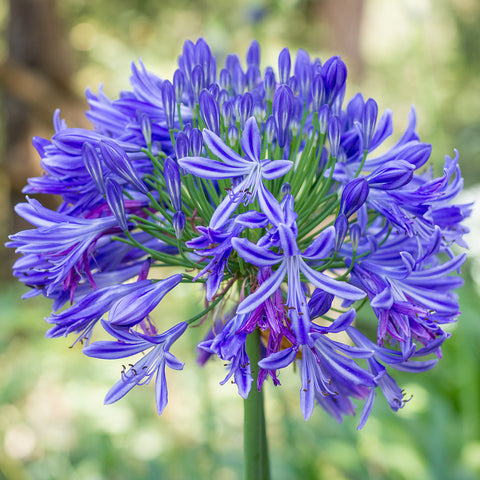Agapanthus Companion Plants: Perfect Pairings for Your Yard
Agapanthus Companion Plants: Perfect Pairings for Your Yard
Blog Article
Letting Loose the Secret to Successful Agapanthus Cultivation: Idea for a Flourishing Yard
In the world of gardening, cultivating agapanthus successfully needs a critical strategy that includes various facets of plant care. By comprehending the nuances of agapanthus growing, one can create an atmosphere where these plants prosper and grow generously.
Planting Agapanthus: Finest Practices
When growing Agapanthus, correct soil prep work is important for making sure effective growth and development of these attractive flowers. Agapanthus, typically called Lily of the Nile or African lily, thrives in well-draining soil with a somewhat acidic to neutral pH degree - Agapanthus. Before planting, it is critical to amend heavy clay soils with natural matter such as garden compost or peat moss to enhance drainage and provide essential nutrients for the plants
To grow Agapanthus, pick an area that obtains complete sunlight to partial shade, as this will advertise healthy and balanced development and abundant blooming. Dig a hole two times the size of the plant's root round and put the Agapanthus at the very same depth it was previously growing. Gently backfill the hole with dirt, pushing down firmly to get rid of any type of air pockets around the origins.
Water the newly planted Agapanthus extensively and continue to maintain the dirt evenly moist, specifically during the plant's active growing season. Agapanthus. Using a well balanced fertilizer once a month can even more support the plant's growth and blooming. By complying with these ideal techniques for planting Agapanthus, you can create a magnificent screen of these fascinating blossoms in your garden
Suitable Soil Issues for Agapanthus
For optimal development and growing success of Agapanthus plants, ensuring the soil conditions are optimal is vital. Agapanthus grows in well-draining dirt with a somewhat acidic to neutral pH degree ranging from 6.0 to 7.0. This sort of dirt allows for adequate water drainage, stopping waterlogging which can lead to root rot. To boost dirt drainage, take into consideration including natural issue such as compost or peat moss when preparing the growing site. In addition, Agapanthus prefers dirt that is rich in nutrients, so integrating a balanced fertilizer throughout the expanding period can promote healthy growth and dynamic blooms.

Watering and Feeding Tips
To make certain healthy and balanced development and vivid flowers, proper watering and feeding methods are important for effective Agapanthus farming. Agapanthus plants benefit from regular watering, specifically Your Domain Name throughout the growing period.
When it concerns feeding Agapanthus, a well balanced plant food with equal parts nitrogen, phosphorus, and potassium can be used in the springtime to promote healthy development and blooming. Slow-release plant foods are optimal for offering nutrients slowly over an extended duration. Avoid over-fertilizing, as this can bring about extreme vegetation development at the expense of blooms.
In addition, integrating raw material like compost into the dirt can enhance nutrient degrees and boost soil structure, assisting in the overall wellness of the Agapanthus plants. By complying with these watering and feeding ideas, gardeners can ensure their Agapanthus plants prosper and generate spectacular screens of flowers.
Trimming and Deadheading Methods
Appropriate trimming and deadheading techniques play an essential role in maintaining the health and wellness and visual appeals of Agapanthus plants, matching the important techniques of watering and fertilizing for successful growing. Trimming Agapanthus entails getting rid of invested blossom heads, dead or yellowing leaves, and general shaping of the plant to promote much better growth. Deadheading, the process of removing faded blossoms, not only enhances the plant's appearance yet additionally urges further growing.
When deadheading Agapanthus, it is a good idea to snip off the blossom stem at the base making use of sharp, clean shears. This procedure reroutes the plant's power from seed production back into origin and vegetation growth, promoting a much healthier and a lot more durable plant. Regular deadheading can extend the growing period of Agapanthus and avoid self-seeding, which can lead to congestion.
In terms of pruning, Agapanthus normally advantages from a light trim after blossoming to clean up the plant and motivate fresh growth. Reducing the spent flower stems and removing any broken or dead foliage aids keep the plant's vitality and total look. Nevertheless, it is vital to stay clear of cutting into the crown of the plant, as this can deteriorate its wellness.

Protecting Agapanthus From Vermins and Diseases
Executing efficient insect and disease monitoring techniques is essential to guarding the wellness and vitality of Agapanthus plants in cultivation. One usual pest that influences Agapanthus is the Agapanthus borer, a caterpillar that passages into the plant, triggering damages to the flowers and leaves.
In addition to parasites, Agapanthus are susceptible to illness such as origin rot and fungal leaf areas. By remaining attentive and dealing with pest and condition issues immediately, gardeners can aid their Agapanthus grow and flourish.

Final Thought
In verdict, effective growing of agapanthus calls for appropriate planting techniques, optimal soil conditions, sufficient watering and feeding, regular pruning and deadheading, and security from diseases and parasites. By adhering to these tips and tricks, gardeners can guarantee a prospering yard filled with beautiful agapanthus my company blooms. Agapanthus. Keep in mind to keep regular treatment and focus to information to advertise the wellness and long life of these magnificent plants
When growing Agapanthus, appropriate soil prep work is vital for guaranteeing successful development and growth of these beautiful flowers.Water the newly grown Agapanthus extensively and proceed to keep the dirt uniformly wet, particularly throughout the plant's active expanding period.For ideal growth and growing success of Agapanthus plants, ensuring the soil problems are optimal is essential. When hair transplanting or growing Agapanthus, make sure the soil is well-prepared to offer the Agapanthus required foundation for the plants to develop themselves effectively. One typical insect that impacts Agapanthus is the Agapanthus borer, a caterpillar that passages right into the plant, creating damages to the leaves and blossoms.
Report this page